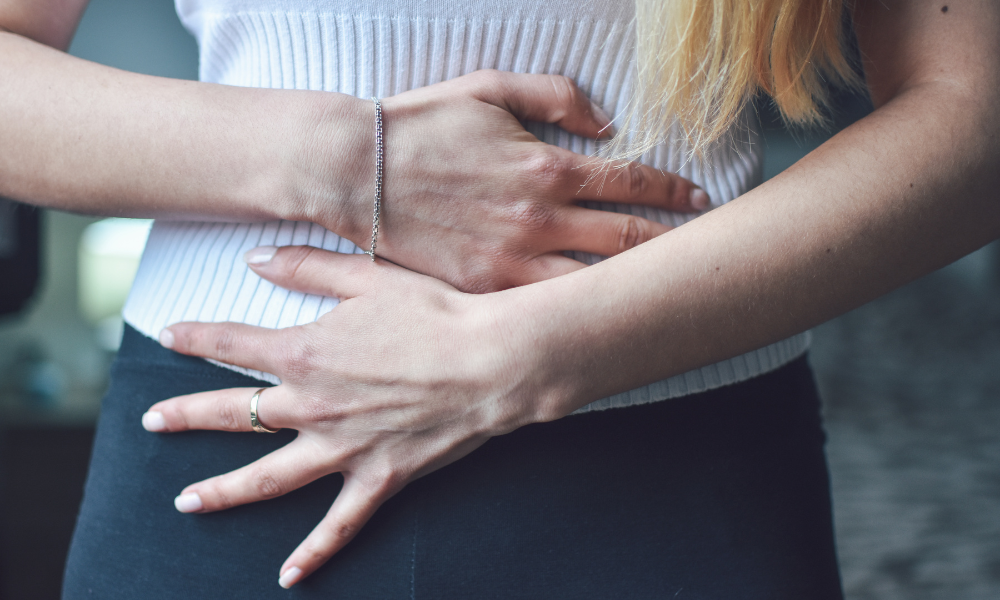Ovarian Cysts
Move Better. Live Fuller. Your Wellness Journey Starts Here.
Schedule a FREE Discovery Call!
What Are Ovarian Cysts?
Ovarian cysts are fluid-filled sacs that can appear on or in the ovaries. There are different types of ovarian cysts, and they are actually very common and harmless. Usually, they produce no symptoms and go away on their own. In some cases, these cysts can be larger than normal, which is where complications or symptoms arise.
When a cyst is larger than normal, it can cause pelvic pain that may feel dull or sharp, as well as bloating or pressure in the abdomen. Some individuals may experience pain with their periods, pain with sex, or urgency to use the restroom. Ovarian cysts may create symptoms such as pain in the thighs or lower back, nausea, and abnormal bleeding.

These larger cysts can put pressure on your pelvic floor as they grow, which can cause symptoms of pelvic floor dysfunction. Pelvic floor dysfunction can present itself in many ways—such as constipation, diarrhea, pelvic pain, and more.
Ovarian cysts may eventually burst. This is common, and doesn’t always cause symptoms. If symptoms are present, they can often be pretty mild. However, this isn’t always the case. In some instances, a bursting cyst can cause a sharp, sudden pain, bloating, and resulting discomfort in the pelvic region during the days following. This may cause spotting or bleeding, as well as abnormal discharge.
In other more rare cases, ovarian cysts may cause severe complications. When the bursting of an ovarian cyst causes intense pain, vomiting, dizziness, and weakness, these symptoms should prompt a visit to the emergency room.
This is because cysts can, in some cases, be caused by infections—which are considered more serious cases, as the infection may release bacteria into the body. In other cases depending on the cyst’s size, twisting known as ovarian torsion may occur. When the ovary twists due to a cyst, it can be very painful and dangerous, as it stops blood flow to the ovary. This complication will require emergency care.
If you believe that you have an infected or large cyst, or your symptoms are very severe, we highly recommend you see a provider who can rule out any severe situations first before pursuing physical therapy. While physical therapists in Minnesota are direct access providers, physical therapy would not be able to provide appropriate or immediate care in those more extreme cases.
What Causes Ovarian Cysts?
Ovarian cysts can be caused by a few different conditions or processes in the body. Functional cysts are the most common type of cyst, and are not related to disease. They occur during ovulation, which is the process where a structure in the ovary called a follicle releases an egg.
- One type of functional cyst, called a follicular cyst, occurs when the follicle doesn’t release an egg and instead fills with fluid.
- Another type of functional cyst is a corpus luteum cyst. This type of cyst occurs during ovulation when fluid fills up the corpus luteum, a hormone-producing group of cells formed by the follicle.
In other cases, there are cysts not caused by the natural processes of menstruation. Non-functional ovarian cysts can be caused by the following:
- Polycystic ovarian syndrome (PCOS)
- Pregnancy
- Noncancerous growths
- Cancer
- Endometriosis
- Pelvic inflammatory disease (PID)
There are some factors that make individuals more likely to have ovarian cysts. This can include:
- Having a period or not having reached menopause yet
- Having previous ovarian cysts
- Taking hormonal medication to encourage ovulation
- Endometriosis
Physical Therapy for Ovarian Cysts
Unfortunately, ovarian cysts cannot be prevented—but the symptoms can be better managed with physical therapy. Because of the pelvic pain created by ovarian cysts, especially alongside conditions like PCOS or endometriosis, many individuals who experience these symptoms may experience muscle tension or pelvic floor dysfunction.
The repeated exposure to pain creates tension in the body’s muscles and connective tissue, which can cause a variety of other symptoms as a result. Therefore, pelvic floor physical therapists can reduce muscle tension in the body and pelvic floor through treatments such as manual therapy, joint manipulation, tissue scraping, biofeedback, and more.
Physical therapy can provide general pain relief through manual therapy, therapeutic modalities, electric stimulation, relaxation techniques, and other pain-relieving treatments. This can be especially useful near the time of menstruation, as your pelvic pain may worsen around this time.
In addition to in-office treatments, physical therapists can teach you to address pain at home by teaching you a variety of exercises, stretches, and yoga. They are very experienced in creating individualized exercise plans for their patients, and can help you find a routine that works best for you and your pain.
If you are looking for ways to manage the symptoms caused by ovarian cysts, definitely look into pelvic floor physical therapy. This applies to those who experience troublesome ovarian cysts occasionally and those who are prone to having them more often. Physical therapists are very knowledgeable and experienced with pelvic pain and the conditions that cause it. They can relieve pain from your ovarian cysts, as well as help you better manage other conditions that may worsen your pain. Get started with Hive Therapy and Wellness today by booking a discovery call!
While working with our providers, you may experience any of the following treatment methods as a part of your comprehensive care plan:
- Neuromuscular re-education
- Manual therapy
- Exercise prescription
- Dry needling
- Cupping
- Tissue scraping
- Behavioral modifications
- Therapeutic activities
- Electrical muscle stimulation
- Spinal manipulation
- Therapeutic modalities
- Biofeedback
Ovarian cysts are fluid-filled sacs that can appear on or in the ovaries. There are different types of ovarian cysts, and they are actually very common and harmless. Usually, they produce no symptoms and go away on their own.
In some cases, these cysts can be larger than normal, which is where complications or symptoms arise.
When a cyst is larger than normal, it can cause pelvic pain that may feel dull or sharp, as well as bloating or pressure in the abdomen. Some individuals may experience pain with their periods, pain with sex, or urgency to use the restroom.
Ovarian cysts may create symptoms such as pain in the thighs or lower back, nausea, and abnormal bleeding.
These larger cysts can put pressure on your pelvic floor as they grow, which can cause symptoms of pelvic floor dysfunction. Pelvic floor dysfunction can present itself in many ways—such as constipation, diarrhea, pelvic pain, and more.
Ovarian cysts may eventually burst. This is common, and doesn’t always cause symptoms. If symptoms are present, they can often be pretty mild. However, this isn’t always the case.
In some instances, a bursting cyst can cause a sharp, sudden pain, bloating, and resulting discomfort in the pelvic region during the days following. This may cause spotting or bleeding, as well as abnormal discharge.
In other more rare cases, ovarian cysts may cause severe complications. When the bursting of an ovarian cyst causes intense pain, vomiting, dizziness, and weakness, these symptoms should prompt a visit to the emergency room.
This is because cysts can, in some cases, be caused by infections—which are considered more serious cases, as the infection may release bacteria into the body. In other cases depending on the cyst’s size, twisting known as ovarian torsion may occur.
When the ovary twists due to a cyst, it can be very painful and dangerous, as it stops blood flow to the ovary. This complication will require emergency care.
If you believe that you have an infected or large cyst, or your symptoms are very severe, we highly recommend you see a provider who can rule out any severe situations first before pursuing physical therapy.
While physical therapists in Minnesota are direct access providers, physical therapy would not be able to provide appropriate or immediate care in those more extreme cases.
Ovarian cysts can be caused by a few different conditions or processes in the body. Functional cysts are the most common type of cyst, and are not related to disease.
They occur during ovulation, which is the process where a structure in the ovary called a follicle releases an egg.
- One type of functional cyst, called a follicular cyst, occurs when the follicle doesn’t release an egg and instead fills with fluid.
- Another type of functional cyst is a corpus luteum cyst. This type of cyst occurs during ovulation when fluid fills up the corpus luteum, a hormone-producing group of cells formed by the follicle.
In other cases, there are cysts not caused by the natural processes of menstruation. Non-functional ovarian cysts can be caused by the following:
- Polycystic ovarian syndrome (PCOS)
- Pregnancy
- Noncancerous growths
- Cancer
- Endometriosis
- Pelvic inflammatory disease (PID)
There are some factors that make individuals more likely to have ovarian cysts. This can include:
- Having a period or not having reached menopause yet
- Having previous ovarian cysts
- Taking hormonal medication to encourage ovulation
- Endometriosis
Unfortunately, ovarian cysts cannot be prevented—but the symptoms can be better managed with physical therapy.
Because of the pelvic pain created by ovarian cysts, especially alongside conditions like PCOS or endometriosis, many individuals who experience these symptoms may experience muscle tension or pelvic floor dysfunction.
The repeated exposure to pain creates tension in the body’s muscles and connective tissue, which can cause a variety of other symptoms as a result.
Therefore, pelvic floor physical therapists can reduce muscle tension in the body and pelvic floor through treatments such as manual therapy, joint manipulation, tissue scraping, biofeedback, and more.
Physical therapy can provide general pain relief through manual therapy, therapeutic modalities, electric stimulation, relaxation techniques, and other pain-relieving treatments.
This can be especially useful near the time of menstruation, as your pelvic pain may worsen around this time.
In addition to in-office treatments, physical therapists can teach you to address pain at home by teaching you a variety of exercises, stretches, and yoga.
They are very experienced in creating individualized exercise plans for their patients, and can help you find a routine that works best for you and your pain.
If you are looking for ways to manage the symptoms caused by ovarian cysts, definitely look into pelvic floor physical therapy. This applies to those who experience troublesome ovarian cysts occasionally and those who are prone to having them more often.
Physical therapists are very knowledgeable and experienced with pelvic pain and the conditions that cause it. They can relieve pain from your ovarian cysts, as well as help you better manage other conditions that may worsen your pain.
Get started with Hive Therapy and Wellness today by booking a discovery call! While working with our providers, you may experience any of the following treatment methods as a part of your comprehensive care plan:
- Neuromuscular re-education
- Manual therapy
- Exercise prescription
- Dry needling
- Cupping
- Tissue scraping
- Behavioral modifications
- Therapeutic activities
- Electrical muscle stimulation
- Spinal manipulation
- Therapeutic modalities
- Biofeedback
You can learn more about these treatments on our Treatments Page.





